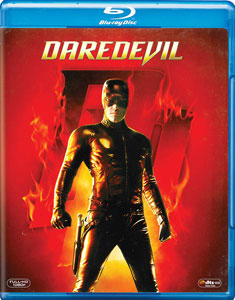I remember “Daredevil” (2003) being a solid – and even serious — superhero movie when I saw it in the theater. But after “Batman Begins” (2005) set a new standard for serious genre films, and after Netflix’s recent “Daredevil” series did justice to the Man Without Fear, the 2003 movie stands in stark contrast as a mediocre adaptation of the Marvel comic.
Simplified narrative
Written and directed by Mark Steven Johnson, who would later do the “Ghost Rider” (2007) film, “Daredevil” feels like it’s waiting for permission to be brooding and serious but didn’t receive approval in time for the theatrical release. Some of the classic “Daredevil” narrative is simplified because it’s a movie, not a TV series where we can spend lots of time with the characters.
But other things are simplified with a goal of simplicity. Most strikingly, Matt Murdock/Daredevil (a game Ben Affleck) doesn’t have any problem with killing. Officially, he’s a lawyer, but in practice he’s a judge, jury and executioner, starting with his murder via subway train of a rapist whom he failed to convict earlier that day. His extra-sensory powers are so strong here that he has a Frank Black-style vision showing the man committing the crime. Daredevil glories in the “justice” killing, leaving a flaming “DD” symbol at the scene.

“Daredevil” (2003)
Director: Mark Steven Johnson
Writer: Mark Steven Johnson
Stars: Ben Affleck, Jennifer Garner, Colin Farrell
He knows murder is wrong and confesses to his pastor as he nominally embarks on an arc where he tries to behave more like a good guy. But Daredevil – and “Daredevil” — doesn’t have his/its heart in the notion. Given a late-film opportunity to fling Bullseye (Colin Farrell) through a window and deliver a one-liner when he lands on a car below, Daredevil takes it (“Bulls-eye,” naturally).
Reporter Ben Urich (Joe Pantoliano) is a straightforward news gatherer rather than a sharp investigative reporter. Franklin Nelson (Jon Favreau), not called Foggy in the film, is a sounding board for Matt and he’s one half of their comedy duo in the scene where Matt turns the tables and gets Franklin to drink the tea with mustard instead of honey in it. You’ll find Karen Page (Ellen Pompeo) in the credits, but she’s barely in the movie, in a lone scene as a secretary at Matt’s office.
Kingpin (the late Michael Clarke Duncan) is a straightforward crime lord doing unsubtle things like frame-jobs. Granted, the film can’t get into nuances of power-gathering and power-holding like a TV series can, but still, there’s no grand scheme at play here.
Under the city lights
The city-lights look of “Daredevil” isn’t bad, but it remains technical rather than drawing a viewer into its world. When Daredevil and Elektra (Jennifer Garner) jump among moonlit Hell’s Kitchen buildings, it’s clearly 2003 CGI – not distracting, but not flawless. Rare moments creep toward a genuine noir aesthetic, with rats and filth and trash-covered alleyways. But Matt’s voiceovers, combined with the CGI action and the cityscape constructed in a computer, give a slick “Sin City” vibe.

Farrell especially exists in the stylized side of the film, giving a broad performance by whipping his cloak around to exit his scenes. Almost every instance of Bullseye flinging an object is portrayed in the “Matrix” style where the camera follows the projectile.
Also illustrating that “Daredevil” is from the “superhero movies aren’t serious” era are the numerous “insider” references. At least three side characters have the precise names of Marvel Comics creators, and famous comic nerd Kevin Smith plays a forensic analyst who feeds info to Urich when bribed.
Some of “Daredevil’s” stylistic shorthand is clever, including Matt’s “radar vision,” which allows him to see Elektra in the rain because the raindrops bounce off her. His hyperbaric chamber is cool, too, emphasizing the fact that he needs a daily escape from sensory overload.
The romance (and brief rivalry due to mistaken identity) between Matt and Elektra works inasmuch as the actors have good chemistry, and a couple of decent Evanescence songs back their scenes. The first is at the funeral of Elektra’s father (Erick Avari) and the second is a montage of Elektra and Matt separately preparing for battle. Unfortunately, the bulk of the soundtrack is turn-of-the-century butt rock, with Nickelback of course leading the charge.
It wants to launch a series
The narrative of Elektra and Matt being trained by Stick is absent from the screenplay, which calls to mind 1989’s “Batman.” Kingpin is directly involved in the origin stories of Matt and Elektra, similar to how the Joker is inserted directly into Batman’s backstory. In both cases, it shrinks the world.
But “Daredevil” still shows confidence that it will become a movie series, with Kingpin vowing to return, Daredevil promising to be waiting for him when he does, and Bullseye recovering in a hospital in a mid-credits scene. Elektra would get her own movie in 2005, but it’s even more poorly regarded than “Daredevil,” and it includes no returning characters other than Elektra herself.
Until the Netflix series came along, I considered the truncation of the “Daredevil” film series to be a loss, because Affleck is good in the role and even in a streamlined version, a blind superhero is a fascinating concept. Even seeing how mediocre and caught-between-two-styles it is today, I still have a soft spot for the movie as a piece of superhero-film history.

